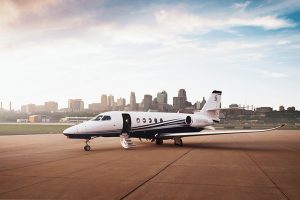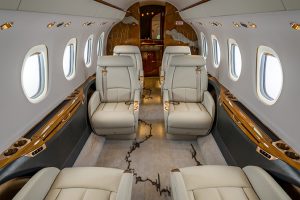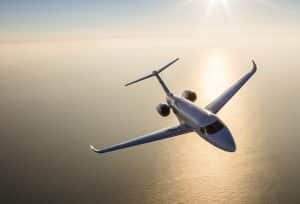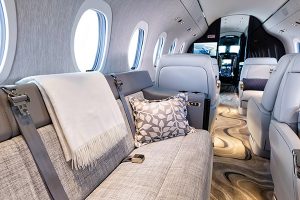Choose Your Direction
The Citation family of business jets began with the maiden flight of the Cessna Fanjet 500 in 1969, competing directly with the Learjet – which was being built on the opposite side of Wichita’s municipal airport.
While the Lear had sex appeal and status, the humbler Citations were gentler planes with simpler landing characteristics, the ability to get in and out of smaller airfields, and much better fuel economy. The Citations became the first business jets to sell by the thousands.
Over the years, the Citation line has stretched, expanded and accelerated with more than a dozen models produced, and the Citation Latitude and Longitude now compose the latest additions to the family.
citation latitude
With nearly 260 jets delivered to date, the Citation Latitude now comprises more than 40 percent of all Midsize business jet deliveries since 2015 and has surpassed 500,000 fleet hours since entry into service.
The Latitude features a combination of short-field performance and comfortable cabin experience, with a stand-up flat floor including best-in-class leg room, spacious lavatory, and seamless cabin connectivity, featuring Bongiovi speakerless, fully immersive surround sound and low cabin altitude. All this comes with an overall lower cost of operation, backed by the most comprehensive service network in general aviation.
The story of the Latitude involves proven technology seamlessly meeting high-tech enhancements. The idea was to take the best features of the Citation Sovereign, improve upon the cabin and avionics, and do so without tackling high-risk features, like new wings, tail or flight control systems. The legendary reliability, serviceability, industry-leading runway performance, low operating costs and competitive purchase price all bear the DNA of a Cessna Citation, but the company pushed further into the realm of technology and comfort than ever before in the Latitude.

The Latitude’s new all-metal design adds to its reliability. Another wise choice made by Cessna was sticking with similar engines used in the Citation Sovereign+ – the rugged, reliable, efficient and proven Pratt & Whitney PW306D1 engines. They also carried over the Sovereign+ moderately-swept wing design with ‘swooplets’ – cutting the time to climb, offering additional speed and range. This offers the capability to fly from LA to New York in just five hours – every second of which can be enjoyed in the comfort of a thoughtfully-designed cabin.
The Latitude’s cabin appeal starts at the floor, which is a true flat floor and at the time of release was the widest and tallest Citation cabin ever – making it feel more like a large cabin jet than a Midsize Jet. Windows were also designed to be larger and perfectly spaced so that each passenger is rewarded with a private view of the world below. Aside from an almost cavernous area for passengers, cabin styling, comfort and technology were cleverly added and stood as major upgrades.
The seats are highly adjustable with options to rotate, recline and shape to passenger’s contours. The fiber-optic cabin-management system allows completely wireless control of cabin functions, allowing each passenger to watch a movie without overwhelming the system. It should also be mentioned that even while zipping through the skies at Mach 0.80, the interior cabin noise remains low enough to make conversation easy.

citation longitude
The Longitude provides aircraft owners with the natural next step to a Super Midsize Jet. The ambitious goals for the Longitude were to offer greater climb, speed and transatlantic range while providing the segment’s best cabin experience (quietest cabin, flat floor, best-in-class-legroom, low cabin altitude) and lowest operating costs.
Cessna entered a crowded Super Midsize market segment but relied on proven designs used in the Latitude, Citation X+ and Sovereign+ models. The Longitude took advantage of some similar structural and system aspects from the very successful and reliable Latitude platform, such as the fuselage diameter, G5000 avionics suite, pressurization system and nose landing gear. To achieve economy, the Longitude uses fly-by-wire systems (rudders, spoilers and brakes have limited fly-by-wire) and features user-friendly maintenance ports, as well as aluminum construction.

The Longitude offers greater range and speed than the Latitude, able to fly nonstop from New York to Paris. While the Latitude has a maximum cruise speed of 513 mph, the Longitude can cruise at 556 mph. Over a 1,000 nautical-mile distance this means that the Longitude is over 14 minutes quicker. Throughout the course of many flights this adds up to significant time savings, and less time in air will result in more flights between needed maintenance. In fact, the Longitude features best-in-class maintenance intervals (18 months/800 hours) backed by the furthest reaching service network, granting aircraft owners direct access to more than 3,000 expert employees, including service representatives offering personalized maintenance, inspections, parts, repairs, avionics upgrades, equipment installations, refurbishments and other specialized services.
The Latitude and Longitude also share the same fuselage shape and flat floor cabin, but the Longitude offers a 25 ft 2 in long cabin (from cockpit divider to aft bulkhead) with room for eight to 12 passengers, depending upon configuration. The slide/swivel/reclining seats are wide and plush, offering more passenger legroom than any other aircraft in its class and allowing most of the single executive seats to be full berthing. The Longitude also offers large-jet amenities such as a large walk-in baggage area and seamless connectivity including a Bongiovi speakerless system that provides fully-immersive surround sound.
Rounding out notable cabin enhancements is the partial recirculation system. Cabin air is sourced from the engines’ bleed air system, where high temperatures sterilize the air. Return air is pushed through a HEPA filtration system – which can capture microscopic particles and prevent the reintroduction of contaminated air to the passenger cabin.

Related Stories
Top 25 Travel Destinations for Flying Private: 6-10
Discover the destinations Jet Linx can take our Aircraft Owners and Jet Card Members around the world.
READ MORE
Top 25 Travel Destinations for Flying Private: 1-5
Discover the destinations Jet Linx can take our Aircraft Owners and Jet Card Members around the world.
READ MORE
Jet Linx Aircraft Management: Buying Power
Jet Linx transforms purchasing scale and tech-optimized analysis of pricing, planning and tankering decisions across our nationwide operations into fuel savings our Aircraft Owners.
READ MORE
Related Stories
Top 25 Travel Destinations for Flying Private: 6-10
Discover the destinations Jet Linx can take our Aircraft Owners and Jet Card Members around the world.
READ MORE
Top 25 Travel Destinations for Flying Private: 1-5
Discover the destinations Jet Linx can take our Aircraft Owners and Jet Card Members around the world.
READ MORE
Jet Linx Aircraft Management: Buying Power
Jet Linx transforms purchasing scale and tech-optimized analysis of pricing, planning and tankering decisions across our nationwide operations into fuel savings our Aircraft Owners.
READ MORE



Contact Us